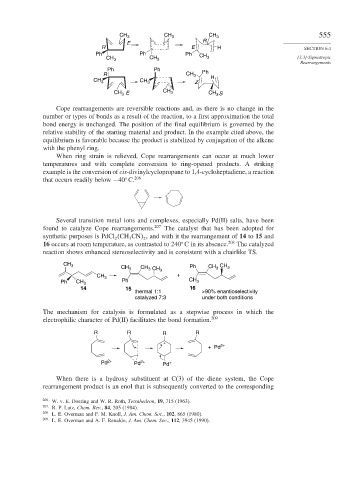Page 581 - Advanced Organic Chemistry Part B - Reactions & Synthesis
P. 581
CH 3 CH 3 CH 3 555
E R
R E H SECTION 6.4
Ph Ph Ph CH
CH 3 CH 3 3 [3,3]-Sigmatropic
Rearrangements
Ph Ph
R CH 3 Ph
CH 3 CH 3 Z H
CH 3 E CH 3 CH 3S
Cope rearrangements are reversible reactions and, as there is no change in the
number or types of bonds as a result of the reaction, to a first approximation the total
bond energy is unchanged. The position of the final equilibrium is governed by the
relative stability of the starting material and product. In the example cited above, the
equilibrium is favorable because the product is stabilized by conjugation of the alkene
with the phenyl ring.
When ring strain is relieved, Cope rearrangements can occur at much lower
temperatures and with complete conversion to ring-opened products. A striking
example is the conversion of cis-divinylcyclopropane to 1,4-cycloheptadiene, a reaction
that occurs readily below −40 C. 206
Several transition metal ions and complexes, especially Pd(II) salts, have been
found to catalyze Cope rearrangements. 207 The catalyst that has been adopted for
synthetic purposes is PdCl CH CN , and with it the rearrangement of 14 to 15 and
2 3 2
16 occurs at room temperature, as contrasted to 240 C in its absence. 208 The catalyzed
reaction shows enhanced stereoselectivity and is consistent with a chairlike TS.
CH 3 CH 3 CH CH Ph CH CH 3
3
3
CH 3 3 +
Ph CH 3 Ph CH 3
14 15 16
thermal 1:1 >90% enantioselectivity
catalyzed 7:3 under both conditions
The mechanism for catalysis is formulated as a stepwise process in which the
electrophilic character of Pd(II) facilitates the bond formation. 209
R R R R
+
+ Pd 2+
Pd 2+ Pd 2+ Pd +
When there is a hydroxy substituent at C(3) of the diene system, the Cope
rearrangement product is an enol that is subsequently converted to the corresponding
206
W. v. E. Doering and W. R. Roth, Tetrahedron, 19, 715 (1963).
207
R. P. Lutz, Chem. Rev., 84, 205 (1984).
208 L. E. Overman and F. M. Knoll, J. Am. Chem. Soc., 102, 865 (1980).
209
L. E. Overman and A. F. Renaldo, J. Am. Chem. Soc., 112, 3945 (1990).

